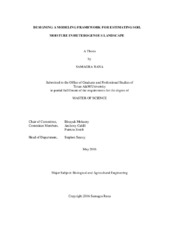| dc.description.abstract | Soil moisture is an important component in many hydrologic and land– atmosphere interactions. Proper characterization of soil moisture variability is vital for understanding hydrological, ecological and biogeochemical processes. At the Darcy scale, root zone soil moisture variability can effectively be estimated by employing an accurate process based model. In this study, we used different conceptual soil-water flow models (single porosity and dual porosity) to predict soil moisture variability across the Little Washita watershed, Oklahoma. The soil hydraulic parameters (SHPs) for the models were estimated through inverse modeling of multi-step outflow experimental data from soil cores, collected during the Southern Great Plains (SGP) 1997 hydrology experiment, from various parts of the watershed. Single porosity, bimodal and dual porosity models were used to calculate SHPs. With the application of various soil water flow model, non-equilibrium effects and preferential flow were briefly discussed. The validity of different models is presented based on the landscape position (location) characteristics (soil, topography, vegetation, organic matter content) of the soil cores. Using calculated SHPs from various parts of the watershed, soil moisture was predicted using forward modeling from March 1997 to November 1997. Different combinations of soil texture, topography, vegetation and organic content influenced the soil hydraulic properties and in soil moisture prediction. For most of the soil samples, dual porosity model was able to capture the micro and macro heterogeneities better than Durner’s and single porosity model. But factors such as landscape position, organic matter and vegetation significantly contributed in predicting soil moisture. Our soil moisture predictions were validated with remotely sensed soil moisture values. Based on our validation, a combination modeling scheme is suggested for soil water model selection for various parts of the watershed. | en |


